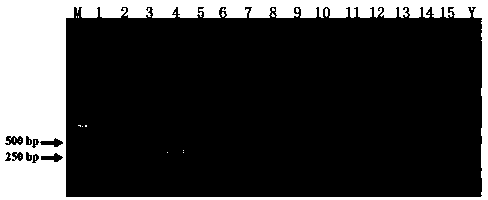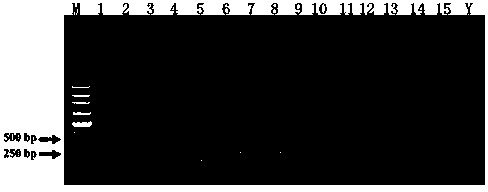Primer for multi-PCR (Polymerase Chain Reaction) detection aiming at fusaria and application of primer
A fusarium, multiple technology, applied in the field of molecular biology, can solve time-consuming and troublesome problems, and achieve the effect of accurate distinction
- Summary
- Abstract
- Description
- Claims
- Application Information
AI Technical Summary
Problems solved by technology
Method used
Image
Examples
Embodiment 1
[0023] The extraction of embodiment 1 DNA
[0024] Reagents involved in the examples: CTAB extract: containing 20 mM EDTA, 100 mM Tris-HCl, 1.4 M NaCl and 2% CTAB by volume.
[0025] The bacterial strain involved in the embodiment: 3 strains of Fusarium graminearum ( F. graminearum ), 3 strains of Fusarium verticillium ( F. verticillioides ), 3 strains of Fusarium laminarum ( F. proliferatum ), 1 strain of Fusarium asiatica ( F. asiaticum ), 1 rice bakanae strain ( F. fujikuroi ), 1 strain of Fusarium oxysporum ( F. oxysproum ), 1 Magnaporthe grisea strain ( Magnaporthe oryzea ), 1 Botrytis cinerea ( Botrytis cinerea ) and 1 strain of Sclerotinia sclerotiorum ( Sclerotinia sclerotiorium ). The above-mentioned strains are common plant pathogenic fungi, which can be obtained by conventional separation and purification methods, that is: take the disease-healthy junction of plant-susceptible samples, disinfect them with 70% ethanol for 5 seconds under aseptic co...
Embodiment 2
[0028] Example 2 Primer Design and Synthesis
[0029] According to the ketoacid-reductoisomerase encoded by different Fusarium ILV5 Genes and genes encoding sterol 24-C reductase ERG24B For the base difference of the gene, three sets of allele-specific PCR primers Fg-F + Fg-R, Fv-F + Fv-R and Fp-F + Fp-R were designed. The primer sequences are shown in Table 1.
[0030]
[0031] The above primers were synthesized by Shanghai Biological Engineering Co., Ltd.
Embodiment 3
[0032] Example 3 Analysis of Primer Specificity
[0033] With the DNA of 9 kinds of fungi described in embodiment 1 as template, with three groups of primers described in embodiment 2 to SEQ ID NO.1 and SEQ ID NO.2, SEQ ID NO.1 and SEQ ID NO.2 and SEQ ID NO.2 and SEQ ID NO.1 ID NO.1 and SEQ ID NO.2 were amplified by PCR respectively, and amplified according to the following PCR reaction system and reaction conditions, and a negative control was set for each reaction (sterilized double-distilled water was used to replace the DNA template), and the PCR reaction The products were detected by gel electrophoresis and photographed by EB staining.
[0034] PCR reaction system: 10×PCR Buffer 2.5 μl, 1.5U Taq enzyme, dNTPs 0.2 μM, MgCl 2 2 mM, 2 μl of DNA template and 0.2 μM each of primers Fg-F and Fg-R described in Example 2 or 0.2 μM each of Fv-F and Fv-R or 0.2 μM each of Fp-F and Fp-R, plus sterilization Double distilled water to 25 μl.
[0035] The Taq enzyme and its correspo...
PUM
 Login to View More
Login to View More Abstract
Description
Claims
Application Information
 Login to View More
Login to View More - R&D
- Intellectual Property
- Life Sciences
- Materials
- Tech Scout
- Unparalleled Data Quality
- Higher Quality Content
- 60% Fewer Hallucinations
Browse by: Latest US Patents, China's latest patents, Technical Efficacy Thesaurus, Application Domain, Technology Topic, Popular Technical Reports.
© 2025 PatSnap. All rights reserved.Legal|Privacy policy|Modern Slavery Act Transparency Statement|Sitemap|About US| Contact US: help@patsnap.com



